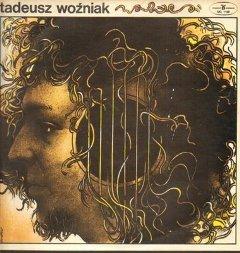Tadeusz Wozniak – Odcien Ciszy (1974)
Tadeusz Woźniak – Odcień Ciszy (1974)

1. Pewnego dnia o świcie (3:49) 2. Dosłowność (3:46) 3. Motyw obsesyjny (4:37) 4. Dziwni ludzie (3:04) 5. Świat jak zwariowany (2:46) 6. I nim się ockniesz (1:35) 7. Odcień ciszy (14:41) 8. Tren o róży (3:46) - Tadeusz Woźniak - vocals, acoustic guitar - Tomasz Jaśkiewicz - guitar - Feliks Michalski - acoustic guitar - Wojciech Bruślik - bass guitar - Tomasz Ocholski - Fender piano - Ryszard Gromek - percussions - Aleksander Bem - Drums - vocal group Alibabki - backing vocals
… wtedy właśnie moja kariera piosenkarska się załamała. Wydałem kolejną płytę "Odcień ciszy", którą zresztą uważam za najlepszą w moim dorobku. Liczyłem na sukces, a tu klapa. Zacząłem zdawać sobie sprawę, że tracę kontakt z publicznością.
Płyta była inna. Bo ja byłem inny. "Odcień ciszy" - nadal do tekstów Chorążuka - to moja odpowiedź na to, co zacząłem dostrzegać w Polsce. Zobaczyłem, że z tymi pomarańczami to był blef. Poczułem się oszukany. Przez Gierka, przez socjalizm. Był rok 1974, atmosfera w mediach zmierzała do wprowadzenia poprawek do konstytucji. Coraz szerzej otwierałem oczy. W "Dosłowności" śpiewam, że jestem "przydrożnym kamieniem i nic mnie nie obchodzi".
Ludzie jednak nie tego potrzebowali. To było jeszcze za wcześnie. Kupowali mnie jako młodego człowieka, który z przejęciem opowiada o tym, że w tak pięknym świecie nawet śmierć jest piękna. W wydaniu bardziej refleksyjnym, kontestacyjnym ich nie interesowałem. ---Tadeusz Woźniak , wyborcza.pl
Issued in 1974, two years after the enormous success of Zegarmistrz Swiatła, the poet Bogdan Chorążuk and musician Tadeusz Woźniak continued their collaboration on a second LP, Odcień Ciszy (Shades of Silence), a recording that often seems to straddle a kind of symphonically scaled emotional impact and some of the inventive structures and ambitions of Progressive Rock, at the height of its international popularity at the time of release. In the lyric here, as elsewhere in Chorążuk and Woźniak’s collaborations, a self-conscious obscurity merges with natural symbols, Chagall-like images of airborne, hair-strung violins and intimations of some kind of transfiguration. The text reminds me a little of Richard Crashaw’s Musick’s Duell, written in the 1640s, mainly owing to certain coincidentally baroque qualities and some apparent similarity of intent in matching text to music: the violins and their symbolic flights, as described by Woźniak’s voice, seem matched by the music’s arrangement, created by Woźniak in collaboration with Henryk Wojciechowski. This suggests the words are intended as a kind of semi abstract tonal colouring, intent on creating atmosphere rather than specific or easily understood meaning. It goes without saying, then, that this version is as much an exercise in intuition and relatively free improvisation on the song’s imagery than anything more literally faithful to the Polish text on which it is based. --- easternblocsongs.wordpress.com
download: uploaded yandex 4shared mediafire solidfiles gett mega zalivalka filecloudio anonfiles oboom
Last Updated (Sunday, 27 April 2014 20:07)








